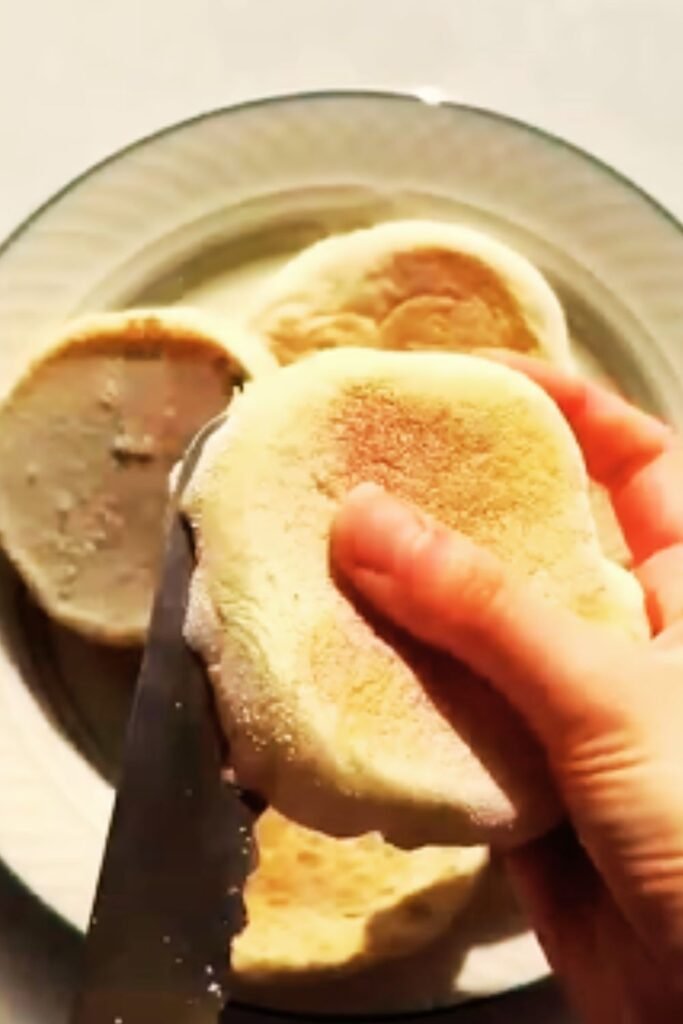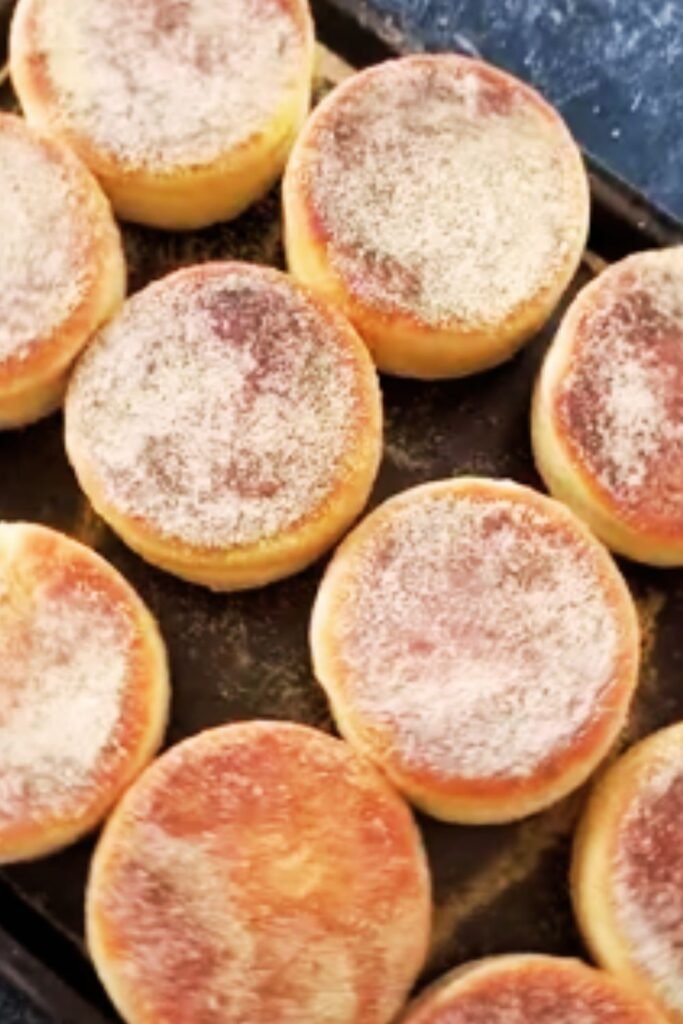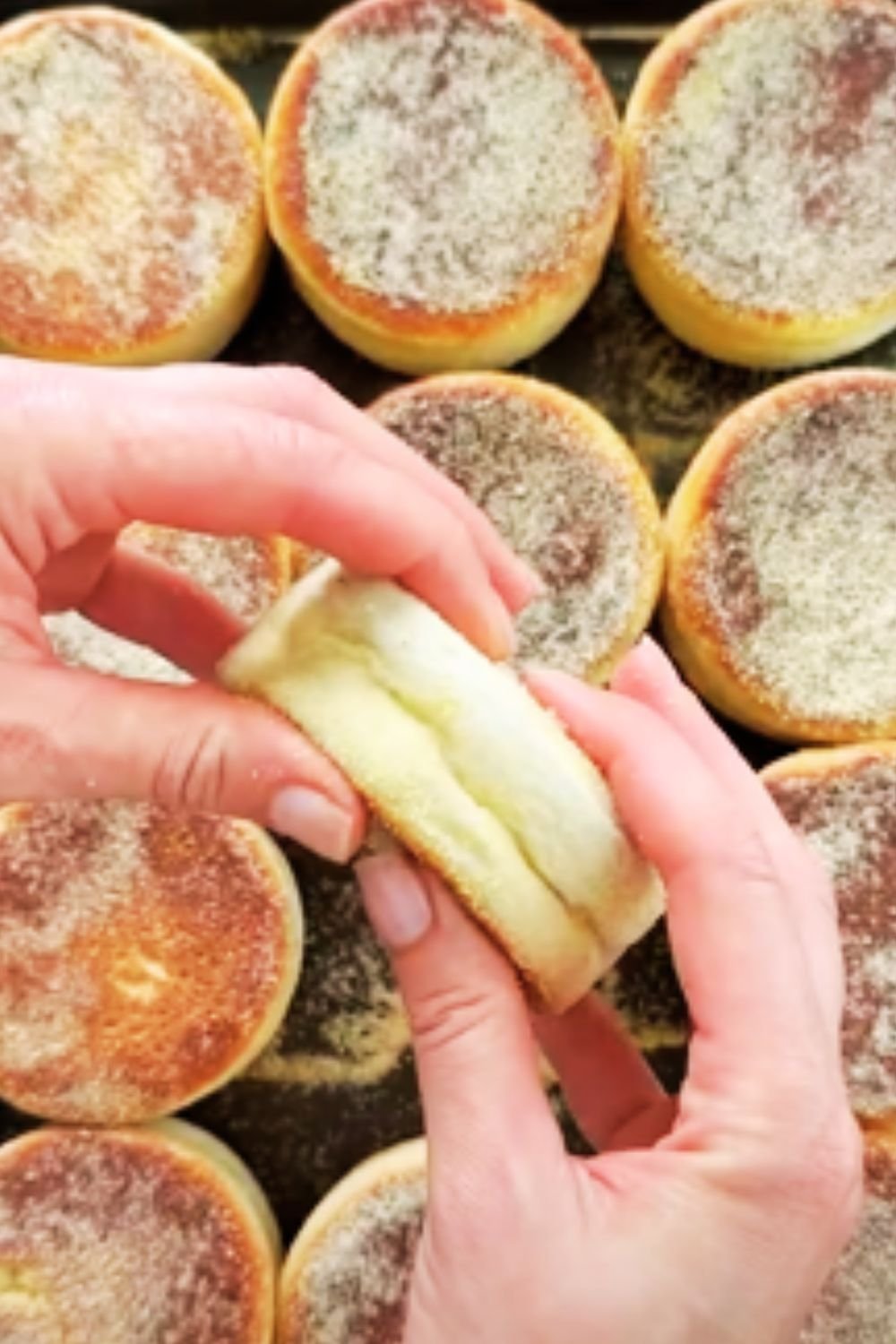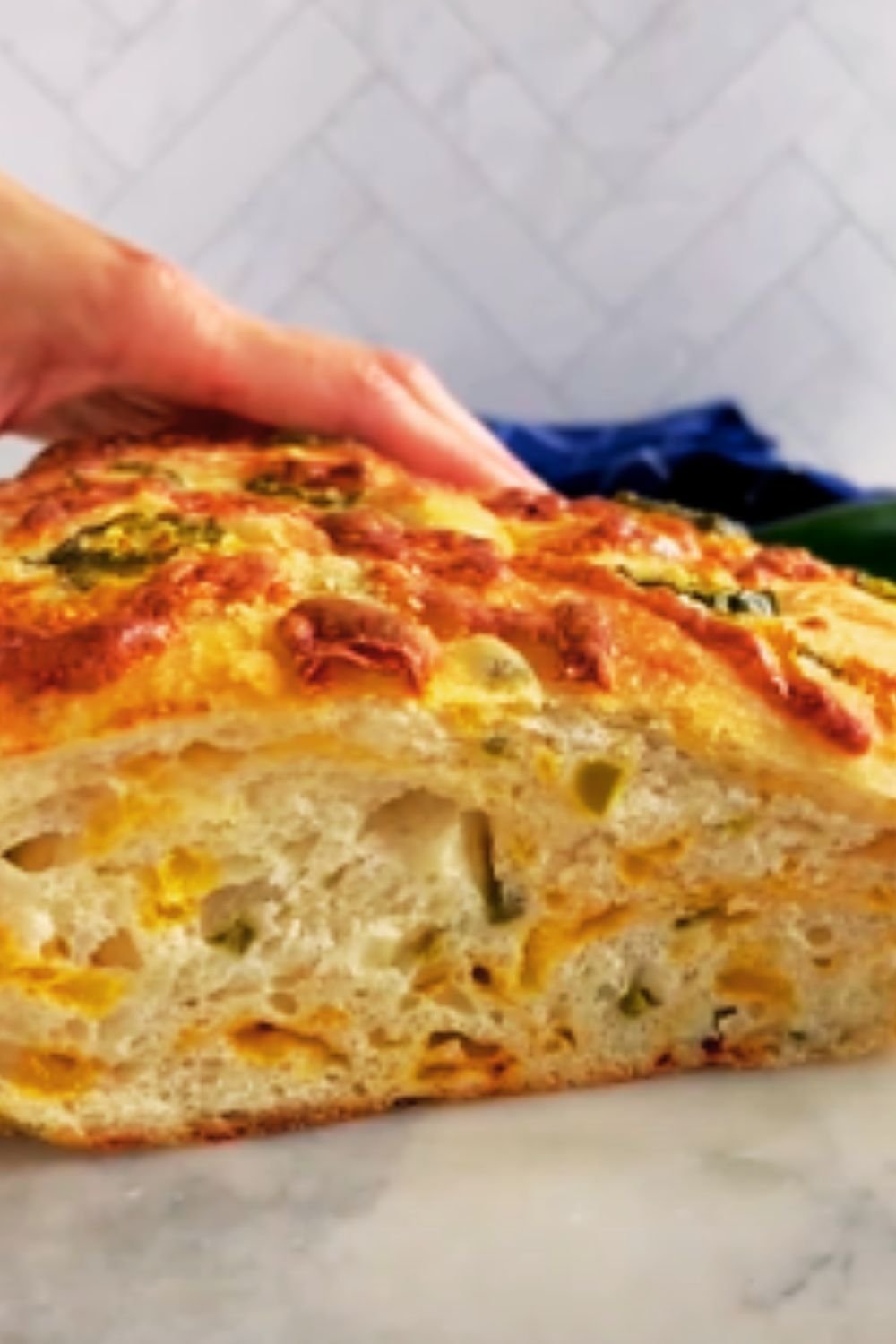There’s something magical about the first bite of a homemade sourdough English muffin – that distinctive tang, those signature nooks and crannies that capture melted butter perfectly, and the satisfying contrast between the crispy exterior and soft, chewy interior. I’ve been perfecting this recipe for years, and I’m excited to share my foolproof overnight method that makes the process both easy and rewarding.
Unlike store-bought versions, these sourdough English muffins have depth of flavor that comes from slow fermentation and the natural leavening power of sourdough starter. The overnight rest not only develops complex flavors but also makes this recipe convenient for busy schedules. Mix the dough before bed, and you’re just a few steps away from fresh English muffins in the morning!
Whether you’re a sourdough enthusiast looking to expand your repertoire or someone taking their first dive into the world of natural fermentation, these English muffins are approachable and immensely satisfying. Let’s get started on this delicious baking adventure together!
What Makes These English Muffins Special
These aren’t your ordinary English muffins. My sourdough version offers:
- Enhanced Flavor: The slow fermentation process develops a delightful tanginess and depth that commercial muffins simply can’t match
- Better Texture: Naturally occurring bubbles create those famous nooks and crannies we all love
- Digestibility: The long fermentation process breaks down gluten and phytic acid, making these easier to digest than commercial versions
- No Commercial Yeast: This recipe relies entirely on your sourdough starter for leavening
- Make-Ahead Convenience: The overnight process fits perfectly into busy schedules
Ingredients You’ll Need
For approximately 12 English muffins:
| Ingredient | Amount | Notes |
|---|---|---|
| Active sourdough starter | 100g (about 1/2 cup) | Should be at peak activity, bubbly and doubled |
| All-purpose flour | 400g (about 3 1/4 cups) | Unbleached preferred |
| Whole wheat flour | 50g (about 1/3 cup) | Adds flavor and nutrition |
| Milk | 300ml (1 1/4 cups) | Whole milk creates the richest texture, but any milk works |
| Water | 60ml (1/4 cup) | Room temperature |
| Honey | 20g (1 tablespoon) | Can substitute maple syrup or sugar |
| Salt | 10g (1 1/2 teaspoons) | Fine sea salt preferred |
| Butter | 30g (2 tablespoons) | Unsalted, softened |
| Cornmeal or semolina | For dusting | Prevents sticking and adds texture |
Essential Equipment
- Digital kitchen scale (for accuracy)
- Large mixing bowl
- Dough scraper
- Rolling pin
- 3.5-inch round cutter (or a clean tin can)
- Cast iron skillet or heavy-bottomed pan
- Cooling rack
Step-by-Step Instructions
Day 1: Evening – Prepare the Dough (15 minutes active time)
- Feed your starter: If you haven’t already, make sure your starter is active and bubbly by feeding it 8-12 hours before making the dough.
- Mix the dough:
- In a large bowl, combine the active sourdough starter, milk, water, and honey
- Whisk until the starter is fully dissolved
- Add both flours and mix with your hands or a wooden spoon until no dry flour remains
- Cover the bowl with a damp cloth and let it rest for 30 minutes (this is called autolyse)
- Add butter and salt:
- After the rest period, add the softened butter and salt to the dough
- Knead in the bowl for about 5 minutes until the dough becomes smooth and the butter is fully incorporated
- The dough will be soft and slightly tacky but should clear the sides of the bowl
- First rise:
- Cover the bowl with plastic wrap or a damp towel
- Let the dough rise at room temperature (around 70°F/21°C) for 2 hours
- You should see some activity and slight expansion, but it won’t double yet
- Refrigerate overnight:
- Transfer the dough, still covered, to the refrigerator
- Let it slowly ferment overnight (8-12 hours)
- This cold fermentation develops flavor and makes the dough easier to handle
Day 2: Morning – Shape and Cook (45 minutes active time)

- Prepare your workspace:
- Generously dust a clean work surface with cornmeal or semolina
- Line a baking sheet with parchment paper and dust with more cornmeal
- Shape the muffins:
- Remove the dough from the refrigerator – it should have risen noticeably
- Turn the dough out onto the dusted surface
- Gently roll the dough to about 3/4 inch (2 cm) thickness
- Using your cutter, cut rounds from the dough
- Place each round on the prepared baking sheet, leaving at least 1 inch between them
- Re-roll the scraps and cut more rounds until all the dough is used
- Second rise:
- Dust the tops of the muffins with more cornmeal
- Cover loosely with a clean kitchen towel
- Let rise at room temperature for 45-60 minutes until puffy (they won’t quite double)
- Cook the muffins:
- Heat a cast-iron skillet or heavy-bottomed pan over medium-low heat
- Working in batches, place 3-4 muffins in the dry, hot pan (no oil needed)
- Cook for 5-7 minutes on the first side until golden brown
- Flip and cook for another 5-7 minutes on the second side
- The internal temperature should reach 190°F (88°C) when fully cooked
- Transfer to a cooling rack
- Cool completely:
- Allow the muffins to cool for at least 30 minutes before splitting
- This allows the interior to set properly for the best texture
How to Split and Serve

To get those beautiful nooks and crannies, use a fork to split your English muffins rather than a knife:
- Insert the tines of a fork around the circumference of the muffin, piercing about halfway through
- Continue around the entire edge
- Gently pull the halves apart with your fingers
- Toast to desired doneness
Serving Suggestions
These homemade sourdough English muffins shine with simple toppings that complement their tangy flavor:
Classic Options:
- Salted butter and honey
- High-quality jam or preserves
- Cream cheese and fresh fruit
- Almond butter and sliced bananas
Savory Ideas:
- Avocado, salt, pepper, and red pepper flakes
- Softly scrambled eggs with herbs
- Smoked salmon, cream cheese, capers, and dill
- Hummus and roasted vegetables
Meal Inspiration:
- Breakfast sandwiches with egg, cheese, and breakfast meat
- Mini pizzas with tomato sauce, cheese, and toppings
- Open-faced sandwiches with various spreads and toppings
- Eggs Benedict base (my personal favorite!)
Storage and Freezing Guidelines
| Storage Method | Duration | Instructions |
|---|---|---|
| Room Temperature | 2-3 days | Store in an airtight container or bread bag |
| Refrigerator | Up to 1 week | Keep in an airtight container |
| Freezer | Up to 3 months | Freeze in a single layer, then transfer to a freezer bag |
For frozen muffins, thaw at room temperature and then toast before serving for the best texture.
Troubleshooting Guide
| Issue | Potential Cause | Solution |
|---|---|---|
| Muffins are too flat | Starter wasn’t active enough | Ensure starter is at peak activity before using |
| Not enough rise time | Allow more time during the second rise | |
| Dough is too sticky to handle | Too much hydration | Add a bit more flour during mixing or dust generously when handling |
| Dough wasn’t chilled enough | Return to refrigerator for 30 more minutes | |
| Muffins are doughy inside | Pan temperature too high | Lower heat to prevent outside cooking too quickly |
| Not cooked long enough | Increase cooking time and check internal temperature | |
| Not enough nooks and crannies | Overhandling the dough | Handle dough gently after fermentation |
| Not enough fermentation | Extend the bulk fermentation time |
Variations to Try
Once you’ve mastered the basic recipe, try these delicious variations:
Whole Wheat Sourdough English Muffins
- Replace half of the all-purpose flour with whole wheat flour
- Add an extra 15ml (1 tablespoon) of water to account for higher absorption
Cinnamon Raisin
- Add 1 tablespoon of ground cinnamon and 80g (1/2 cup) of raisins when mixing the dough
- Soak the raisins in warm water for 10 minutes and drain before adding
Herb and Garlic
- Add 2 tablespoons of fresh herbs (such as rosemary, thyme, or chives)
- Include 2 minced garlic cloves or 1 teaspoon garlic powder
Cheese and Scallion
- Fold in 80g (about 1 cup) of grated sharp cheddar and 3 chopped scallions after the first rise

Sourdough Starter Tips
If you’re new to sourdough, here are some tips for maintaining a healthy starter:
- Keep your starter at the consistency of thick pancake batter
- Feed your starter equal parts flour and water by weight (100g flour to 100g water)
- For best results in this recipe, feed your starter 8-12 hours before mixing the dough
- A mature starter (at least 2 weeks old) will yield the best flavor and rise
Why This Recipe Works
The science behind these delicious sourdough English muffins:
- Cold Fermentation: The overnight refrigeration slows yeast activity while allowing beneficial bacteria to develop flavor compounds
- Milk Proteins: The milk in the dough helps create a tender crumb and contributes to browning
- Two-Stage Cooking: The initial stovetop cooking sets the shape, while the continued heat fully cooks the interior
- Fork-Splitting: This traditional technique preserves the natural texture by pulling the crumb apart rather than cutting through it
Frequently Asked Questions
Can I use discard instead of active starter? No, this recipe requires active, bubbly starter at its peak. Using discard will result in dense muffins with poor rise. If you only have discard, feed it and wait 6-8 hours before proceeding.
Why are my English muffins not developing nooks and crannies? The distinctive texture comes from proper fermentation and handling. Ensure your starter is active, don’t overwork the dough after fermentation, and use the fork-splitting method rather than cutting with a knife.
Can I make these dairy-free? Yes! Replace the milk with your favorite plant-based milk (oat milk works particularly well) and substitute the butter with coconut oil or a vegan butter alternative. The texture might be slightly different but still delicious.
How can I tell when the muffins are properly cooked? The most reliable method is using an instant-read thermometer – the internal temperature should reach 190°F (88°C). If you don’t have a thermometer, the muffins should feel light for their size and sound hollow when tapped on the bottom.
Can I make the dough and shape the muffins ahead of time? Yes! You can shape the muffins and refrigerate them (covered) for up to 24 hours before cooking. Allow them to come to room temperature for about 30 minutes before cooking.
Why cook these on the stovetop instead of baking? Traditional English muffins are cooked on a griddle or in a skillet. This method creates the characteristic flat top and bottom while allowing the sides to rise, creating that authentic English muffin shape. Baking would produce a different texture more similar to rolls.
My dough seems too wet – did I make a mistake? Sourdough English muffin dough should be softer and more hydrated than regular bread dough. If it’s truly too wet to handle after refrigeration, you can incorporate a small amount of flour when rolling it out, but resist the urge to add too much as it will make the muffins dense.
Can I double this recipe? Absolutely! This recipe doubles beautifully – just maintain the same ratios. You might need to work in more batches when cooking the muffins.
Final Tips for Success
- Temperature matters: Both for your ingredients and cooking surface. If your kitchen is cold, consider extending the rise times slightly.
- Be patient: Sourdough works on its own timeline. The fermentation process develops flavor and texture, so don’t rush it.
- Watch the heat: Cooking at too high a temperature will burn the outside before the inside is cooked. Medium-low heat is perfect.
- Weigh your ingredients: For consistent results, use a digital scale rather than volume measurements.
- Practice makes perfect: Each batch will teach you something about the process. Keep notes on what works best in your kitchen environment.
There’s something deeply satisfying about mastering the art of sourdough English muffins. The process connects us to centuries of baking tradition while producing something far superior to mass-produced versions. I hope this recipe brings as much joy to your kitchen as it has to mine!
These homemade English muffins are the perfect weekend project – just enough steps to feel accomplished, but simple enough to become a regular part of your baking routine. Enjoy the process and, most importantly, enjoy every butter-soaked bite of your delicious creation!


